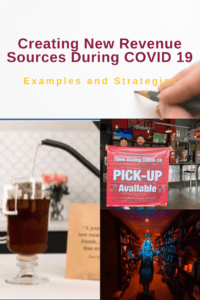Objectives
By the end of this post, you will be able to:
- Research and brainstorm new sources of revenue
- Strategically build out an idea while minimizing cost and maximizing results
- Identify and utilize community resources for assistance
- Identify next steps to boost your venture’s digital strategy
Entrepreneurs are resilient and persistent. Starting and managing a venture requires endless creative problem solving as new challenges seem to appear every day. The COVID-19 pandemic, however, has created a wave of unprecedented challenges that are threatening to overwhelm entrepreneurs across the country. As the world adjusts to a new normal, how many business models can survive the changes?
Get Inspired, Get Started
Rather than trying to wait it out, this is the perfect time for entrepreneurs to call upon that same resilience and persistence to now reimagine what their businesses can looks like. Maybe this involves turning to a new market, developing a new set of products or both! This type of business model change is often called a “pivot” or “revenue diversification” and it is a strategic approach for a business to remain relevant. This is a daunting endeavor but Arizona entrepreneurs from a variety of industries have already started adapting and thriving. Get started with a spark of inspiration from their stories:
Peoria’s Creative Arts Earn National Recognition for their out of the box innovation
Forbes Magazine Article
From Coffee Roaster To Personalized Coffee, Tea and Chocolate Cards
Daily Independent Article
Local Restaurants turned into local food markets
ABC News Article
Find Good Ideas
But, how did these entrepreneurs come up with the big idea behind their pivot? This question highlights three useful entrepreneurial approaches: many entrepreneurs uncovered a potential solution through research, others started asking for input, and some brave entrepreneurs took the creative guardrails off completely to dream up something totally unique. Each approach has it’s strengths and they are even more powerful when used together.
Research is a great way to see which ideas have already been tested and what lessons have been learned. Start by examining how local competitors have pivoted in similar circumstances and then branch out to other regions and industries. Be careful not to discount potential solutions too quickly. Insights can come from surprising places! Keep a record of each approach researched as well as considerations of how it might and might not work.
How to start researching:
Search engines like Google are enormously helpful for finding information—simply type in a word, phrase or question and the search engine returns web pages, news articles, videos and more that it thinks are a match. It is important to know, however, that different search results are returned depending on what key words are used (even though “kitty”, “cat” and “kitty cat” are all about the same topic, searching each one returns different results). So, try searching a topic several times using different key words to get a better collection of information. The best sources of information on the topic of successful business diversification/pivot due to COVID are likely to come from news stories, articles from chambers of commerce or other business groups, and industry or academic publications. As you research, you are likely to come across additional key words that you can try.
⇒ Check out this Mashable guide for more tips on using Google effectively for research by clicking here.
The Small Business Development Center (SBDC) has local offices around the country with expert counselors that can lend a hand for entrepreneurs with existing businesses. When it comes to research, they have access to a special collection of databases as well as experience working with entrepreneurs dealing with similar challenges.
⇒ Check out the local Maricopa SBDC website to sign up for a counseling session by clicking here.
How to start asking for input:
Surveys are a great tool for easily gathering targeted information from a large number of people. Having a large “sample size” is important because it improves the precision and accuracy of the conclusions that can be drawn. Surveys can be helpful, for instance, for established businesses with a current client base who want to learn more about their customer’s needs or what they would like to see from that type of business. This information could then be used to better decide how to pivot one’s product or market strategy. One challenge with surveys, however, is that they do not allow for collaboration. A respondent cannot be easily asked to elaborate on an interesting answer or be able to expand on something interesting that someone else has mentioned.
⇒ Check out a whitepaper from CXellence for a thorough exploration of customer survey topics one could address by clicking here.
Brainstorming with sticky notes is a classic and highly effective method to facilitate collaborative solution finding. This method begins by gathering a diverse group of participants and then setting two important ground rules:
- Be open–withhold judgment of ideas and don’t be afraid to come up with “wild” suggestions.
- Go for quantity–stay focused on the topic and go for as many ideas as possible.
Next, post the problem statement (a single-sentence description of the problem to be solved) on a wall or digital canvas. Group members should then write every solution they can think of on individual sticky notes (real or digital) and post them! Reading each sticky note out loud before posting is a great way to further inspire ideas. After the group runs out of ideas, sort the sticky notes out loud by themes while taking note of common threads and popular ideas. Some ideas may be able to be combined later into a single solution. Ensure to record the idea wall for reference in future sections. Finally, finish the session by voting on ideas to determine which move forward.
⇒ Check out the sticky note method in action with a video from IDEO, the world-renowned design company, by clicking here.
⇒ Check out Mural, a free digital collaboration tool, designed to help remote group members share ideas by clicking here.
Blue sky thinking is a special type of brainstorming which totally removes consideration for practical constraints and allows for all creative ideas—even those totally disconnected from reality. Constraints are valuable when honing the effectiveness of a solution but they can also restrict our thinking so truly innovative ideas get ruled out too early. This approach is effective because it resets how the problem is being been framed to allow for fresh thinking and the generation of ideas with the potential to spark new insights and elaboration.
How to start blue sky thinking:
“If you had a magic wand…” is an example of a prompt which can be used to effectively reset the framing of a problem so that blue sky thinking can occur. The word “magic” is particularly helpful because it removes any constraint tied to technology, funding or market forces. The prompt can be used during an individual or group blue sky thinking session (i.e. Q: “If you had a magic wand, how would you solve…”; A: “If I had a magic wand, I would just…”). The sticky note approach can also be used during group sessions to keep track of ideas and elaboration.
⇒ Check out Draw Something, a free collaborative drawing game, to help clear minds and spark connective thoughts before blue sky sessions by clicking here.
Build Small, Build Fast
When evaluating a potential solution, it is important to determine what the fastest and most affordable version of it looks like. This will take careful consideration of how the potential solution actually solves the problem and then drilling down to see if that method can be done in a similar way but faster and cheaper. For example, if a person had a problem that it takes too long to walk to work, one could suggest that save up to buy a car. But, if that person is healthy and only lives short distance from work, saving up to buy a bicycle could actually be a faster and cheaper solution to their specific problem. Taking the bus would be an even faster and cheaper solution!
This approach (sometimes called Minimum Viable Product or MVP) is useful not only to conserve resources but also to get an idea into the real world for testing as soon as possible. As soon as a potential solution can be tested, the sooner it can generate feedback and be further adjusted. In the example of the person needing to get to work faster, perhaps they took the advice and tried the bus the next morning. But, they found that it makes too many stops and the set bus schedule is a hassle. At that stage, the person has only invested a few dollars and it is now clear that a bicycle would solve all of those issues.
Because it is impossible to know if a potential solution will be successful, it is best to determine the fastest and cheapest way to try it!
Next Steps
Research, asking and blue sky are three strategies to help any entrepreneur explore ways to innovative in our new environment. Those are just a few ways to leverage different entrepreneurial approaches to thrive in our constantly changing world. What approaches have you used? What examples of innovative pivots have inspired you? Post in the comments below.
Technology is playing a big role in an entrepreneur’s successful pivot whether it is establishing a presence online, leveraging ecommerce solutions or building a stronger community. To get up to speed on these tools, visit the Peoria Forward webpage to view upcoming programs that focus on access to the digital economy. Learn about selling online with Shopify, driving sales through Facebook and Instagram, as well as building a free business website in an hour.
As a community, entrepreneurs resilient and persistent to continue to move the world forward with amazing ventures and creative ideas.






